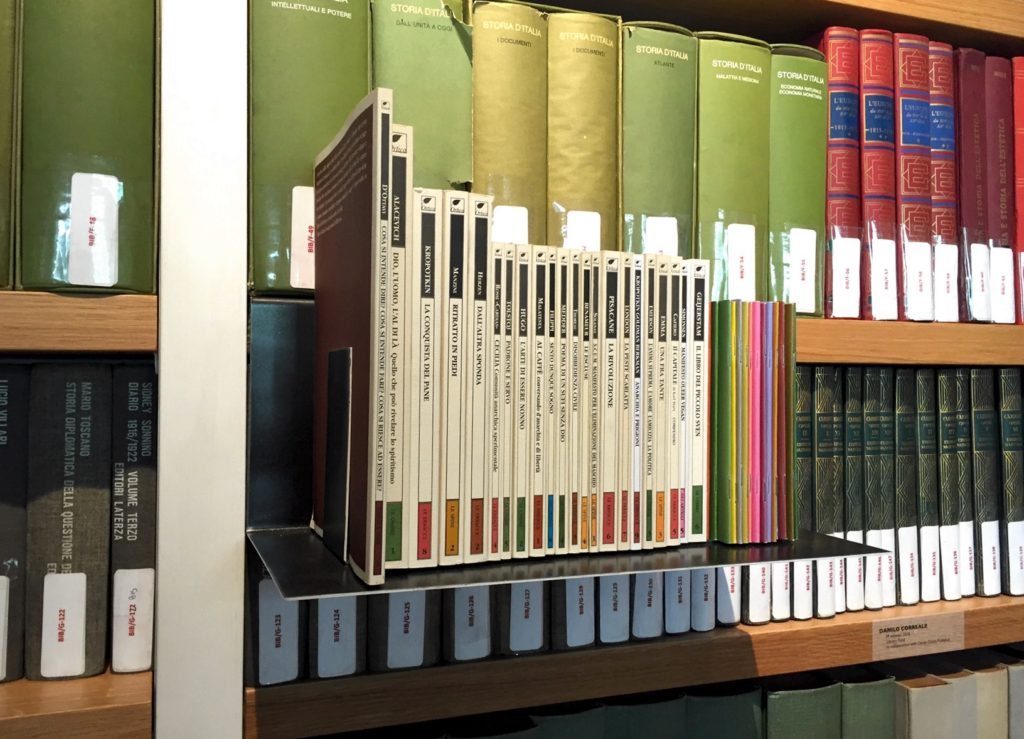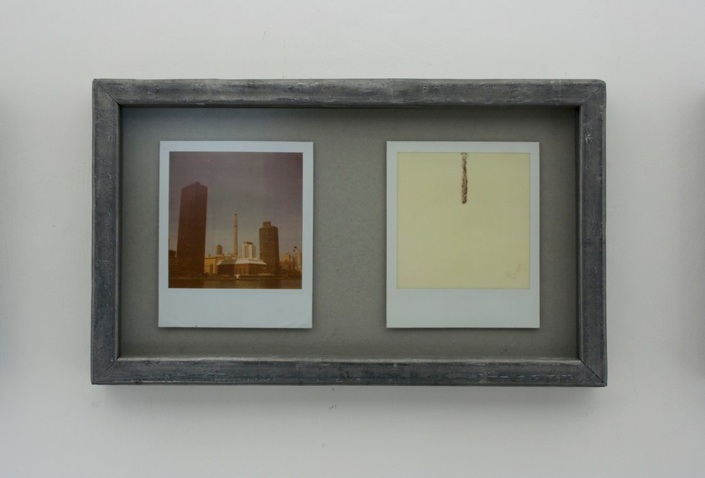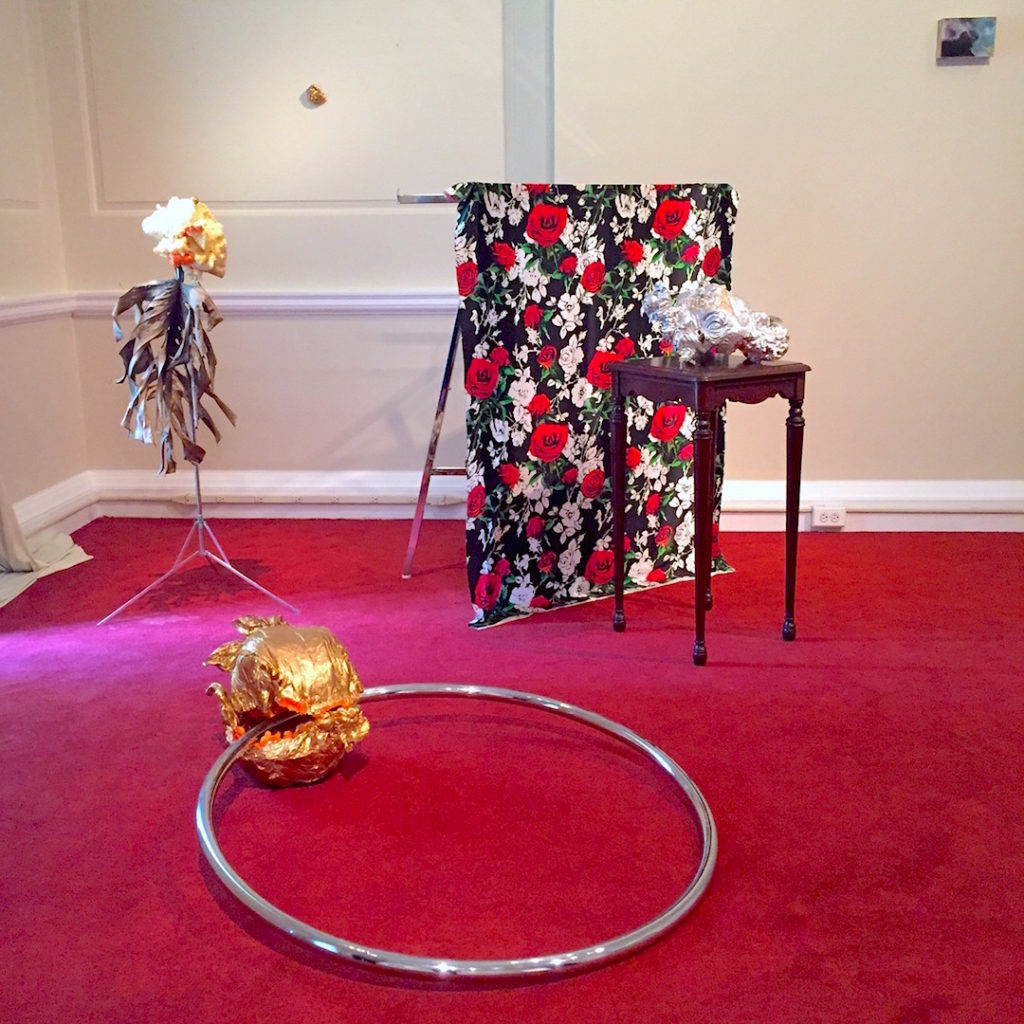
Danilo Correale, 39 Volumes, 2016, Installation view at the Istituto Italiano di Cultura, New York, Photograph by Katy Hamer, 2016
What does it mean to be America, or American rather? Beyond the legalese, is it a state of mind, a privilege, a struggle, or a get of jail free card in the eyes of the world? In reality and during a time of growing populations throughout the globe, including migrants leaving or being forced to leave their homelands, American stands and remains as one of the most desirable, even if at times unattainable, places to go. It is a country born of immigrants and diverse from the beginning. With this diversity, we know now, as we’ve always known, that a responsibility needs to be cared for specifically around any question of the other. A country declared a country by immigrants, it has grown and flourished at the hands of those who have breached its shores and traversed its sky. Within this context of idealism, the American way of life has come to represent around the world, there are of course flaws. What this exhibition at the Instituto Italiano di Cultura, New York strives to address is really just the tip of the iceberg in a large ongoing dialogue around immigration, class, and what is the American dream.
Taken from a poem written by Allen Ginsberg in 1956 titled, “America”, “It Occurs To Me That I Am America” was co-organized by four young Italian curators including, Ludovica Capobianco, Alessandro Facente, Veronica Santi and Giulia Trabaldo Togna. Each of the four, brought various artists to the table and were part of a discussion and intense editing process, in order to show the artists who they felt best could illustrate —either directly or indirectly— the journey of an artist from another land, working and exhibiting in the US. In excerpt from Ginsberg’s poem;
I’m addressing you.
Are you going to let your emotional life be run by
Time Magazine?
I’m obsessed by Time Magazine.
I read it every week.
Its cover stares at me every time I slink past the corner
candystore.
I read it in the basement of the Berkeley Public Library.
It’s always telling me about responsibility. Business-
men are serious. Movie producers are serious.
Everybody’s serious but me.
It occurs to me that I am America.
I am talking to myself again.
Ginsberg was beyond doubt a linguistic master, creating musical interludes with his words and the breaks in each line of his texts. In this particular poem, he delves into not only what America is, but what it appears to be from the outside looking in as well as what it is from the inside looking out. There is a culture of blame (America you don’t really want to go to war. / America it’s them bad Russians. / Them Russians them Russians and them Chinamen. / And them Russians.) a reserved intersection of time, spliced and taped back together like an old movie reel desperate to be rewatched. It seeks to define without definition, to inquire without question and declare without conviction. Ginsberg, was a white male who identified as queer in a time when much of the American culture was still resting under a gauzy layer of censorship. Using words as his gun, his silent yet loud voice and his barbaric yawp. Ginsberg sounds off deriding a more traditional path (joining the army, working in a parts factory) for his own, if unconventional at the time, drive ending “America” with the line, America I’m putting my queer shoulder to the wheel.

Gian Maria Tosatti, New York, 2011-2013, Polaroid film, lead frame, watercolor, Image courtesy of the artist
As an exhibition, “It Occurs To Me That I Am America” is full of hope if not hopeful. It is an honest look at the lifestyle that one is promised versus the reality of place. The artists represented, Matteo Callegari, Arianna Carossa, Danilo Correale, Renato D’Agostin, Alessandro Del Pero, Andrea Mastrovito, Maria Domenica Rapicavoli, and Gian Maria Tosatti are all Italian natives who have ventured to the US in search of creative fodder, change, career advancement and maybe even to fulfill a particular dream. Some are based in the US on a full-time basis while others came for a residency or choose to divide time between the United States and Europe. What is it like to make work, something extremely personal whether an artist admits it or not, away from one’s country and in a land that has come to be known as one that holds promise? In the light of recent massacres, the country’s flaws are more easily defined and visible, a reopening of fissures that had been attempted to be mended. While none of the works in the exhibition necessarily address race, they do venture into disillusionment. The phrase “I Am America” is not one to be used lightly and while Ginsberg may have had his tongue firmly planted in his cheek, he also spoke with a determination and intrinsic desire. It is the desire that is missing in some of the works whether that is the fault of the curators who attempt to pedagogical approach to determine what America is or the artist’s who were unable to conjure work to fit this weighted content. However, many of the art steps up to the plate and not only participates in the conversation at hand, but also expands upon the dialogue by admittedly bringing their own cultural origination into the mix.

Arianna Carossa, “The failure of American appearance” (2016), Installation view, Istituto Italiano di Cultura, New York, Photograph by Katy Hamer, 2016
Such is the case with Danilo Correale, Arianna Carossa and Gian Maria Tosatti in particular. Each of these artists has a very particular way, nearly melancholic, of transporting their own history with them as an invisible, weighted luggage, which translates through the work that is shown. Carossa uses a variety of mediums arranging objects, together in what one might initially assume to be quite precarious assemblages. She quite literally uses items found on the street and brought back to the studio. In one notable piece titled,”The failure of American appearance” she uses a rack that

Danilo Correale, in collaboration with Publishing House Ortica, Interior book detail, Photograph by Katy Hamer, 2016
was discarded by the former American Apparel store on Ludlow street in the Lower East Side. The title alone hints at the American aesthetic which is an actual thing (as is the Italian aesthetic, French aesthetic, Japanese aesthetic) and extends beyond the stereotype of the Ralph Lauren prep. When the work communicates or taps into something that could be translated as failure, is when it is most successful. This is also the case with the conceptual book project by Danilo Correale in collaboration with the Ortica publishing house. The artist printed 39 volumes and with a declaration inside the first few pages, Correale alerts the reader to the project and how each of the curated books is focused around specific Italian texts that present a historical resonance through idealism, escaping from the barbarism of the past in search of a better future. The books are installed on an L-shaped frame that extends into the space beyond the normal bookshelves. It functions as a parasite, as do the books which belong, yet do not belong. It could be said that this is also how many foreigners feel within the borders of a country that is not their own. The project is informative yet intrusive as it interrupts the general flow of the library. Much like the translation of the Italian word ortica, nettle, the books function as the plant does, finding it’s way into cracks in the concrete and in places it may be unwanted.
Also on view is a series of framed Polaroid photographs by artist Gian Maria Tosatti. Tosatti made the photographs while in residence at the Lower Manhattan Cultural Council, Governor’s Island location. Originally from Rome, the artist walked around Manhattan in strict observance of the landscape. In doing so, he became highly aware of the many smoke stacks which are scattered throughout the boroughs and no longer in use. Taking the Polaroid pictures, he then used an exposed photograph and painted the smoke directly where it would have once been in the negative space. Nostalgia and failure along with the observation of something unsightly that many disregard or choose to not see, is a big part of Tosatti’s practice and here he establishes a narrative that has since vanished in thin air. Also in the same room as this series are objects from “Disrupted Accounts” an ongoing body of work by Maria Domenica Rapicavoli. The objects, are fragments of a German plane from WWI that the artist came across during an exploratory visit to Mount Etna. Each object, rusted yet somehow precious, sits atop a white pedestal, granted a newfound importance. Focusing on the conflicts and resolutions between Italy and the US, the artist gives new meaning to these shapes in their divorced home, far from where they were meant to be.
To return to our initial inquiry of what does it mean to be America, or American, the exhibition doesn’t necessarily provide an answer. Rather, we are given information that can further expand a conversation in more than one language. Even though it was organized and shown in New York, I have a strong feeling that the curators spoke in his or her mother tongue, inquiring about the visual resolution to best convey an age-old interrogation.
“It Occurs To Me That I Am America” was on view at the Istituto Italiano di Cultura, New York from May 20th through July 8th, 2016. It was organized by young Italian curators including Ludovica Capobiano, Alessandro Facente, Veronica Santi and Giulia Trabaldo Togna. For more on each artist please visit the respective links: Matteo Callegari, Arianna Carossa, Danilo Correale, Renato D’Agostin, Alessandro Del Pero, Andrea Mastrovito, Maria Domenica Rapicavoli, and Gian Maria Tosatti
Katy Diamond Hamer is the founding editor of Eyes Towards the Dove and contributes to many magazines. She can be found @katyhamer on Instagram
